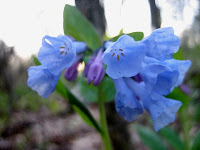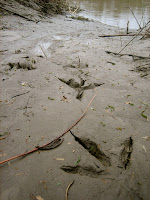
90 hermit thrush
91 ruby-crowned kinglet
92 eastern towhee
93 brown thrasher
(total on this date in 2006: 89)APRIL 16, ROCK BRIDGE,
sunny, 70—I'm lucky to have a bird spotter, Donna, who from time to time reports spring arrivals to me by cell phone. Today she'd seen a kinglet on the white connector trail at Rock Bridge Memorial State Park.
When I showed up a few hours later it was moving through cedars near a sinkhole pond a short distance from where Donna had described it. In a nearby mini-grove of persimmon trees a hermit thrush flicked its tail. Double bingo!
Before sunset I crossed the road to my favorite part of the park, High Ridge. The last 10 minutes before dark were full of sounds.
I flushed a
barred owl deeper into the trees, where it looked down on me. Near a pond below the ridge a thrasher
sang distinctively (multiple phrases, all repeated twice), though
spring peepers were calling so loudly I could barely hear the thrasher. A turkey
gobbled from the other side of the hill. Two
Canada geese descended and plunged into the pond, just yards away.
Climbing back to the ridge, bats overhead in the darkening sky, I heard a deer
snort. Six watched me, ran hard for 50 yards, then stopped and watched again until I disappeared from view.
 108 common grackle
108 common grackle





